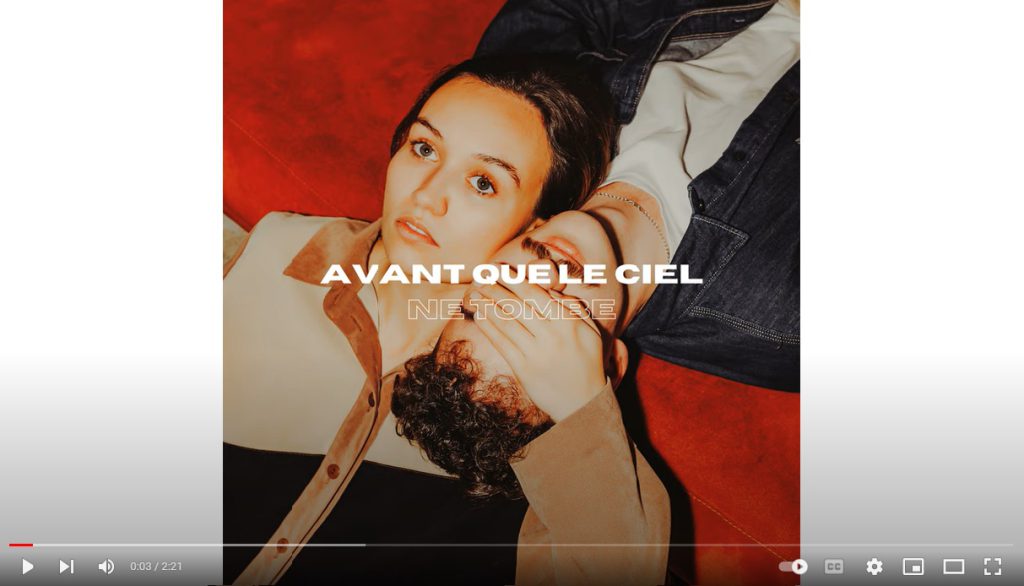Each lunar phase is represented in turn on Meghan Oak’s new EP, Dans la lune, with a release date of April 28, 2023. When it’s full, the moon shines over us, using all the light from the Sun to reveal itself to the world; similarly, Oak is embracing this moment in her life, allowing herself to shine brightly. (Editor’s Note: while literally meaning “in the moon,” the EP title is also a French colloquialism meaning “having one’s head in the clouds.”)
 “It might come across as pretentious,” says the singer-songwriter, “but it took me a long time to admit it, after a lengthy process: I deserve to be in the spotlight.” Just as the Moon follows its cycles, Oak awaited her turn, doubting herself a lot, but is ready now to take flight. Her first EP, Étrangère (2020) and her stint on Star Académie (2021) fed her strong case of impostor syndrome – which she’s now shed completely.
“It might come across as pretentious,” says the singer-songwriter, “but it took me a long time to admit it, after a lengthy process: I deserve to be in the spotlight.” Just as the Moon follows its cycles, Oak awaited her turn, doubting herself a lot, but is ready now to take flight. Her first EP, Étrangère (2020) and her stint on Star Académie (2021) fed her strong case of impostor syndrome – which she’s now shed completely.
“Yoga saved me, and allowed me to get off anti-depressants,” she admits, after having completed a training as a teacher of the discipline. Yoga, which led her to a kind of spirituality, transported her away from negative energy, and gave her the strength to get through both the pandemic, and an arduous romantic break-up.
“When I released Étrangère, all I had was a college education in communications,” says Oak. “People heard about me on social media, and I was struggling to understand why I was getting so much attention, despite having no musical training – and being from a family where my dad was an electrician, and my mom a social worker.”
The artist endlessly questioned what gave her the permission to “stand in the light” that being a singer afforded her. “I asked myself what I had to share that was so incredible that it was me on that close-up photo,” she says. “Then, I had an epiphany: I’m not putting Meghan Oak in the spotlight! I’m using music to bring people along as we both elevate ourselves.” This explains why she feels as one with pop music, a genre she categorically refuses to relegate to the status of “banal.” She touches on universal subjects: love, environment, feeling unaccepted. “Having a career as a singer doesn’t revolve around me, it’s about giving back,” she says.
In 2022, Oak was one of 25 artists selected to participate in SOCAN Foundation’s TD Incubator for Creative Entrepreneurship. “For nearly three months, I had access to industry pros – managers, PR people, radio trackers, etc. – and what I enjoyed the most was having the chance to meet three mentors who’ve guided me through my career,” she says.
Oak maintains that, as an independent artist, not all aspects of the industry have the same level of difficulty. “I’m my own booking agent, manager, content creator, and so on,” she says. “Artist entrepreneurs deserve as much spotlight and support as artists with a record label,” she adds. The Orchard’s Karine Lafleur, Pop Montréal’s Daniel Seligman, and Universal’s Guillaume Moffet all offered her tips and assistance to help her carry on her business with assurance. “They quickly pointed out the importance of meetings that aren’t directly about the art,” she explains, adding that she was relieved by their helpful advice.
Fully invested, she’s adamant about seeing all the possibilities. “When the moon is full, I’m obsessed with its light, and fourteen days later, when it’s the new moon, we’re in complete darkness – and it’s okay, because we know the light will be back,” says Oak, who gives herself all the leeway she needs to accept her dark moments and enjoy her brighter days.
With the same philosophy, she shines a light on the people who’ve helped her. “There’s not a single song on my EP that I did alone,” she says. Laurence Castera, Amélie Larocque, and DVinyle are part of her creative inner sanctum. Her producer, Ken Presse, co-wrote and co-produced most of Dans la lune.
She’s also thankful for all the shared spaces that gave her an opportunity to make contacts who carried her forward as an independent artist. “It was at the Foyer’s song camp, at Pilou’s BEAM, that I was introduced to DVinyle and Tommy Lunaire,” Oak remembers. “The subject we were tasked with writing a song together was ‘Don’t Look Up.” and it was an incredibly rich collaboration. The result was ‘Avant que le ciel ne tombe.’”
When she writes with someone else in a duo format, Oak starts by having a deep conversation with her co-writers, ensuring that the length travelled on the inner musical path also helps everyone involved move forward. “I always ask the others how they’re feeling,” says Oak. “What do they want to say today? What’s the emotion at the heart of the song? And then we go!
“I’ve never worked as hard as this on an event,” says Oak about her record launch, and the live shows that will follow. “We’re going to unabashedly celebrate Francophone pop, and travel through all the phases of the moon.”
Dans la lune is launched at Montréal’s Le Ministère on April 26, 2023, and Oak is at the SOCAN Gala on May 7, 2023, to share her experience during the Incubator for Creative Entrepreneurship.
